前言
上一篇主要实现前端表单请求加密处理,后端解密的实现,这篇文章将结合shiro来完善登陆认证的流程。
流程
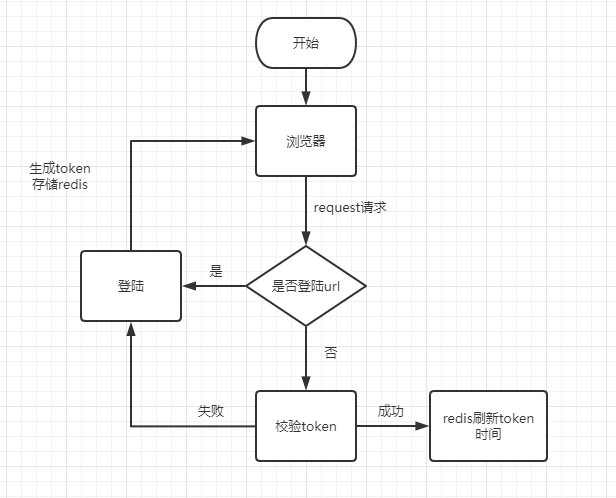
- 浏览器请求接口
- 判断是否是登陆请求
- 是登陆请求执行登陆,否则进行身份认证
- 登陆成功生成token存进redis
- 身份认证通过放行请求, 刷新redis里的token缓存时间
- 认证失败则跳转登陆页重新进行登陆
实现
后端
ShiroConfig.java配置
@Configuration
public class ShiroConfig {
/**
* 注入ShiroRealm,自定义的realm 后面的认证和授权全在这里编写
* @return
*/
@Bean
public ShiroRealm shiroRealm() {
return new ShiroRealm();
}
/**
* 创建SecurityManager
* @return
*/
@Bean
public DefaultWebSecurityManager defaultWebSecurityManager() {
/**
* securityManager对象,shiroRealm进行托管
*/
DefaultWebSecurityManager securityManager = new DefaultWebSecurityManager();
securityManager.setRealm(shiroRealm());
/**
* 禁用session
*/
DefaultSubjectDAO subjectDAO = new DefaultSubjectDAO();
DefaultSessionStorageEvaluator defaultSessionStorageEvaluator = new DefaultSessionStorageEvaluator();
defaultSessionStorageEvaluator.setSessionStorageEnabled(false);
subjectDAO.setSessionStorageEvaluator(defaultSessionStorageEvaluator);
securityManager.setSubjectDAO(subjectDAO);
return securityManager;
}
/**
* 过滤器配置
* @return
*/
@Bean
public ShiroFilterFactoryBean shiroFilterFactoryBean(DefaultWebSecurityManager securityManager) {
ShiroFilterFactoryBean factoryBean = new ShiroFilterFactoryBean();
factoryBean.setSecurityManager(securityManager);
factoryBean.setLoginUrl("/login");
// 添加自定义过滤器
Map<String, Filter> filterMap = new HashMap<>(16);
filterMap.put("tokenFilter", new BearerTokenFilter());
factoryBean.setFilters(filterMap);
/**
* 自定义拦截规则
*/
Map<String, String> filterRuleMap = new HashMap<>(16);
// 对swagger相关url请求不进行拦截
filterRuleMap.put("/doc.html", "anon");
filterRuleMap.put("/swagger-resources/**", "anon");
filterRuleMap.put("/v2/**", "anon");
filterRuleMap.put("/webjars/**", "anon");
// 其余请求都要经过BearerTokenFilter自定义拦截器
filterRuleMap.put("/**", "tokenFilter");
factoryBean.setFilterChainDefinitionMap(filterRuleMap);
return factoryBean;
}
}
BearerTokenFilter拦截器
Shiro有很多默认的过滤器
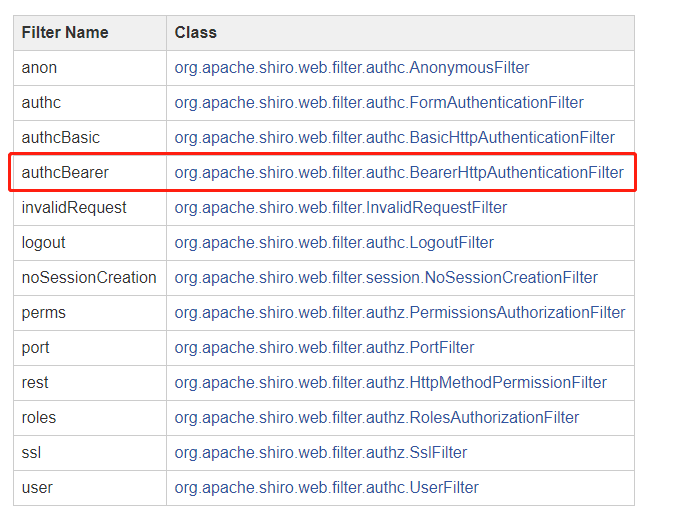
这用token实现,所以选择继承BearerHttpAuthenticationFilter
@Slf4j
public class BearerTokenFilter extends BearerHttpAuthenticationFilter {
/**
* 是否允许通过
* @param request
* @param response
* @param mappedValue
* @return
*/
@Override
protected boolean isAccessAllowed(ServletRequest request, ServletResponse response, Object mappedValue) {
// 如果不是登陆操作,直接进行认证操作
if (!isLoginAttempt(request, response)) {
try {
executeLogin(request, response);
} catch (Exception e) {
log.error("认证异常: {}", e);
// 返回false shiro会自动抛出401 前端接收就好,不用再全局异常捕获。也捕获不到 - -!
return false;
}
}
return true;
}
/**
* 是否试图登陆操作
* @param request
* @param response
* @return
*/
@Override
protected boolean isLoginAttempt(ServletRequest request, ServletResponse response) {
return getAuthzHeader(request) == null && pathsMatch(getLoginUrl(), request);
}
/**
* 执行登陆操作
* @param request
* @param response
* @return
*/
@Override
protected boolean executeLogin(ServletRequest request, ServletResponse response) {
BearerToken bearerToken = new BearerToken(getAuthzHeader(request));
getSubject(request, response).login(bearerToken);
return true;
}
/**
* http请求进行跨域处理
* @param request
* @param response
* @return
* @throws Exception
*/
@Override
protected boolean preHandle(ServletRequest request, ServletResponse response) throws Exception {
HttpServletRequest httpServletRequest = (HttpServletRequest) request;
HttpServletResponse httpServletResponse = (HttpServletResponse) response;
httpServletResponse.setHeader("Access-control-Allow-Origin", httpServletRequest.getHeader("Origin"));
httpServletResponse.setHeader("Access-Control-Allow-Methods", "GET,POST,OPTIONS,PUT,DELETE");
httpServletResponse.setHeader("Access-Control-Allow-Headers", httpServletRequest.getHeader("Access-Control-Request-Headers"));
// 跨域时会首先发送一个option请求,这里我们给option请求直接返回正常状态
if (httpServletRequest.getMethod().equals(RequestMethod.OPTIONS.name())) {
httpServletResponse.setStatus(HttpStatus.OK.value());
return false;
}
return super.preHandle(request, response);
}
}
登陆代码
LoginController.java
@RestController
@Api(tags = "登陆模块")
public class LoginController {
@Autowired
private LoginService loginService;
@PostMapping("/login")
@ApiOperation(value = "登陆")
@DynamicParameters(properties = {
@DynamicParameter(name = "username",value = "用户名",required = true),
@DynamicParameter(name = "password",value = "密码",required = true),
})
public ResResult login(@RequestBody JSONObject user) {
return loginService.doLogin(BeanUtil.toBean(user, User.class));
}
}
LoginServiceImpl.java
@Service
@Log4j2
public class LoginServiceImpl implements LoginService {
@Autowired
private UserService userService;
@Autowired
private RedisUtil redisUtil;
@Value("${privateKey}")
private String privateKey;
@Override
public ResResult doLogin(User user) {
if (StrUtil.isEmpty(user.getUsername()) || StrUtil.isEmpty(user.getPassword())) {
return ResResult.failure(ResResultCode.USERNAME_OR_PASSWORD_ERROR);
}
// 验证 用户
RSA rsa = new RSA(privateKey, null);
String userName = rsa.decryptStr(user.getUsername(), KeyType.PrivateKey);
QueryWrapper queryWrapper = new QueryWrapper<User>();
queryWrapper.eq("username", userName);
User userTemp = this.userService.getOne(queryWrapper);
if (userTemp == null) {
return ResResult.failure(ResResultCode.USERNAME_OR_PASSWORD_ERROR);
}
//验证 密码
// 1、私钥解密rsa 加密的密码
String password = rsa.decryptStr(user.getPassword(), KeyType.PrivateKey);
// 2、不可逆加密密码,比较数据库密码
if (!DigestUtil.bcryptCheck(password, userTemp.getPassword())) {
return ResResult.failure(ResResultCode.USERNAME_OR_PASSWORD_ERROR);
}
// 判断用户是否被禁用
if (userTemp.getLocked().equals(GlobalEnum.STATUS_LOCK.getCode())) {
return ResResult.failure("该账号不已被禁用!");
}
// 验证成功,生成token存进redis
String token = JwtUtil.sign(userTemp.getUsername(), userTemp.getPassword());
redisUtil.set(Constant.LOGIN_PREFIX + userTemp.getId(), token, Constant.TOKEN_EXPIRE);
Map<String, Object> rs = new HashMap<String, Object>(16);
rs.put("token", token);
return ResResult.success(rs);
}
}
之前只是简单进行RSA解码校验,现完善对比数据库用户进行校验用户名和密码是否正确,校验成功生成token存入redis中。解密密方式用hutool提供的 DigestUtil.bcryptCheck()不可逆加密。 对应的加密方式DigestUtil.bcrypt()。
Constant.java常量类
public class Constant {
/**
* token过期时间 15分钟
*/
public final static long TOKEN_EXPIRE = 60 * 15;
/**
* 存放token的header名称
*/
public final static String TOKEN_HERDER_KEY = "Authorization";
/**
* token的前缀
*/
public final static String TOKEN_PREFIX = "Bearer";
/**
* redis存储token的key前缀
*/
public final static String LOGIN_PREFIX = "LOGIN_";
}
编写ShiroRealm
public class ShiroRealm extends AuthorizingRealm {
@Autowired
private UserService userService;
@Autowired
private RedisUtil redisUtil;
/**
* 授权方法
* @param principalCollection
* @return
*/
@Override
protected AuthorizationInfo doGetAuthorizationInfo(PrincipalCollection principalCollection) {
return null;
}
/**
* 认证方法
* @param authenticationToken
* @return
* @throws AuthenticationException
*/
@Override
protected AuthenticationInfo doGetAuthenticationInfo(AuthenticationToken authenticationToken) throws AuthenticationException {
// 获取身份信息
BearerToken bearerToken = (BearerToken) authenticationToken;
// 去掉token前缀
String token = bearerToken.getToken();
token = token.replace(Constant.TOKEN_PREFIX, "").trim();
// jwt解析token 获取用户名
String username = JwtUtil.getUsername(token);
if (StrUtil.isEmpty(username)) {
throw new AuthenticationException("token invalid");
}
// 查询数据库用户是否存在
QueryWrapper queryWrapper = new QueryWrapper<User>();
queryWrapper.eq("username", username);
User user = userService.getOne(queryWrapper);
if (user == null) {
throw new AuthenticationException("User didn't existed!");
}
//验证token是否合法
if (!JwtUtil.verify(token, username, user.getPassword())) {
throw new AuthenticationException("Username or password error");
}
// 验证token 是否过期
String cacheToken = (String) redisUtil.get(Constant.LOGIN_PREFIX + user.getId());
if (StrUtil.isEmpty(cacheToken) || !StrUtil.equals(cacheToken, token)) {
throw new AuthenticationException("token invalid");
}
//验证通过刷新token 时间
redisUtil.expire(Constant.LOGIN_PREFIX + user.getId(), Constant.TOKEN_EXPIRE);
return new SimpleAuthenticationInfo(bearerToken.getToken(), bearerToken.getToken(), "shiroRealm");
}
}
对所有请求进行拦截校验,请求header是否携带Authorization,没有则抛出异常。校验成功从redis取出token刷新缓存时间。
前端
封装信息弹出
IMessage.js
import { Message, MessageBox } from 'element-ui'
const IMessage = {
warn: function (str) {
Message({
message: str,
type: 'warning',
duration: 1500,
offset: 300
})
},
info: function (str) {
Message({
message: str,
type: 'info',
duration: 1500,
offset: 300
})
},
error: function (str) {
Message({
message: str,
type: 'error',
duration: 1500,
offset: 300
})
},
success: function (str) {
Message({
message: str,
type: 'success',
duration: 1500,
offset: 300
})
},
/*
* message:提示消息
* tip:标题
* callbackFun:回调方法
*/
confirm: function (message, tip, callbackFun) {
MessageBox.confirm(message, tip, {
confirmButtonText: '确定',
cancelButtonText: '取消',
type: 'warning'
}).then(() => {
callbackFun()
}).catch(() => {
})
}
}
export default IMessage
封装一个工具类,信息提示可以使用这个类
http请求和响应处理
src/utils/ request.js
import axios from 'axios'
import router from '../router'
import store from '@/store'
import { getToken } from '@/utils/auth'
import IMessage from './IMessage'
// create an axios instance
const service = axios.create({
baseURL: process.env.VUE_APP_BASE_API, // url = base url + request url
// withCredentials: true, // send cookies when cross-domain requests
timeout: 5000 // request timeout
})
// request interceptor
service.interceptors.request.use(
config => {
// do something before request is sent
if (store.getters.token) {
// let each request carry token
// ['X-Token'] is a custom headers key
// please modify it according to the actual situation
config.headers['Authorization'] = getToken()
}
return config
},
error => {
// do something with request error
console.log(error) // for debug
return Promise.reject(error)
}
)
// response interceptor
service.interceptors.response.use(
/**
* If you want to get http information such as headers or status
* Please return response => response
*/
/**
* Determine the request status by custom code
* Here is just an example
* You can also judge the status by HTTP Status Code
*/
response => {
const res = response.data
// if the custom code is not 200, it is judged as an error.
if (res.code !== 200) {
IMessage.error(res.msg || '网络通讯异常,请稍后再试!')
return Promise.reject(new Error(res.msg || 'Error'))
} else {
return res
}
},
error => {
if (error.response && error.response.status === 401) {
IMessage.error('登录失效,请重新登录')
router.replace({
path: '/login',
query: { redirect: router.currentRoute.fullPath }
})
}
// else if (error.response && error.response.status === 403) {
// router.replace({
// path: '/403',
// query: { redirect: router.currentRoute.fullPath }
// })
// }
else {
IMessage.error('网络通讯异常,请稍后再试!')
}
return Promise.reject(error)
}
)
export default service
- 发送http请求的时候,添加token
config.headers['Authorization'] = getToken() - response返回不是code=200,一律弹出信息。捕获error的时候具体分析响应编码,401跳转到登录页,携带重定向地址。
路由文件
import Vue from 'vue'
import Router from 'vue-router'
Vue.use(Router)
/* Layout */
import Layout from '@/layout'
/**
* Note: sub-menu only appear when route children.length >= 1
* Detail see: https://panjiachen.github.io/vue-element-admin-site/guide/essentials/router-and-nav.html
*
* hidden: true if set true, item will not show in the sidebar(default is false)
* alwaysShow: true if set true, will always show the root menu
* if not set alwaysShow, when item has more than one children route,
* it will becomes nested mode, otherwise not show the root menu
* redirect: noRedirect if set noRedirect will no redirect in the breadcrumb
* name:'router-name' the name is used by <keep-alive> (must set!!!)
* meta : {
roles: ['admin','editor'] control the page roles (you can set multiple roles)
title: 'title' the name show in sidebar and breadcrumb (recommend set)
icon: 'svg-name'/'el-icon-x' the icon show in the sidebar
breadcrumb: false if set false, the item will hidden in breadcrumb(default is true)
activeMenu: '/example/list' if set path, the sidebar will highlight the path you set
}
*/
/**
* constantRoutes
* a base page that does not have permission requirements
* all roles can be accessed
*/
export const constantRoutes = [
{
path: '/',
redirect: '/login',
},
{
path: '/login',
component: () => import('@/views/login/index'),
hidden: true
},
// {
// path: '/404',
// component: () => import('@/views/404'),
// hidden: true
// },
{
path: '/dashboard',
component: Layout,
children: [{
path: 'dashboard',
name: 'Dashboard',
component: () => import('@/views/dashboard/index'),
meta: { title: 'Dashboard', icon: 'dashboard' }
}]
},
// {
// path: '/example',
// component: Layout,
// redirect: '/example/table',
// name: 'Example',
// meta: { title: 'Example', icon: 'el-icon-s-help' },
// children: [
// {
// path: 'table',
// name: 'Table',
// component: () => import('@/views/table/index'),
// meta: { title: 'Table', icon: 'table' }
// },
// {
// path: 'tree',
// name: 'Tree',
// component: () => import('@/views/tree/index'),
// meta: { title: 'Tree', icon: 'tree' }
// }
// ]
// },
// {
// path: '/form',
// component: Layout,
// children: [
// {
// path: 'index',
// name: 'Form',
// component: () => import('@/views/form/index'),
// meta: { title: 'Form', icon: 'form' }
// }
// ]
// },
// {
// path: '/nested',
// component: Layout,
// redirect: '/nested/menu1',
// name: 'Nested',
// meta: {
// title: 'Nested',
// icon: 'nested'
// },
// children: [
// {
// path: 'menu1',
// component: () => import('@/views/nested/menu1/index'), // Parent router-view
// name: 'Menu1',
// meta: { title: 'Menu1' },
// children: [
// {
// path: 'menu1-1',
// component: () => import('@/views/nested/menu1/menu1-1'),
// name: 'Menu1-1',
// meta: { title: 'Menu1-1' }
// },
// {
// path: 'menu1-2',
// component: () => import('@/views/nested/menu1/menu1-2'),
// name: 'Menu1-2',
// meta: { title: 'Menu1-2' },
// children: [
// {
// path: 'menu1-2-1',
// component: () => import('@/views/nested/menu1/menu1-2/menu1-2-1'),
// name: 'Menu1-2-1',
// meta: { title: 'Menu1-2-1' }
// },
// {
// path: 'menu1-2-2',
// component: () => import('@/views/nested/menu1/menu1-2/menu1-2-2'),
// name: 'Menu1-2-2',
// meta: { title: 'Menu1-2-2' }
// }
// ]
// },
// {
// path: 'menu1-3',
// component: () => import('@/views/nested/menu1/menu1-3'),
// name: 'Menu1-3',
// meta: { title: 'Menu1-3' }
// }
// ]
// },
// {
// path: 'menu2',
// component: () => import('@/views/nested/menu2/index'),
// name: 'Menu2',
// meta: { title: 'menu2' }
// }
// ]
// },
// {
// path: 'external-link',
// component: Layout,
// children: [
// {
// path: 'https://panjiachen.github.io/vue-element-admin-site/#/',
// meta: { title: 'External Link', icon: 'link' }
// }
// ]
// },
// 404 page must be placed at the end !!!
{ path: '*', redirect: '/404', hidden: true }
]
const createRouter = () => new Router({
// mode: 'history', // require service support
scrollBehavior: () => ({ y: 0 }),
routes: constantRoutes
})
const router = createRouter()
// Detail see: https://github.com/vuejs/vue-router/issues/1234#issuecomment-357941465
export function resetRouter() {
const newRouter = createRouter()
router.matcher = newRouter.matcher // reset router
}
export default router
路由跳转控制
permission.js文件调整
import router from './router'
import store from './store'
import { Message } from 'element-ui'
import NProgress from 'nprogress' // progress bar
import 'nprogress/nprogress.css' // progress bar style
NProgress.configure({ showSpinner: false }) // NProgress Configuration
const whiteList = ['/login'] // no redirect whitelist
router.beforeEach(async (to, from, next) => {
// start progress bar
NProgress.start()
// 白名单直接跳转 如果是登陆路由,清空用户token
if (whiteList.indexOf(to.path) !== -1) {
next()
} else {
//验证是否有token, 有token跳转, 无token或token失效跳转登录页
const token = store.getters.token
if (token) {
next();
} else {
// await store.dispatch('user/resetToken')
Message.error('登陆失效,请重新登陆')
next(`/login?redirect=${to.path}`)
}
}
})
router.afterEach(() => {
// finish progress bar
NProgress.done()
})
获取到token信息,直接放行跳转。否则跳转到登陆页面,执行登陆操作获取token。
测试
步骤
- 登陆
- 登陆成功将跳到/dashboard路由
- dashboard页面请求后端接口
- token过期后刷新页面,是否跳转登陆页
准备
方便测试把token过期时间改成3分钟
public final static long TOKEN_EXPIRE = 60 * 3;
UserController.java添加一个请求用户列表的接口
@GetMapping("/listUser")
@ApiOperation(value = "用户列表")
public ResResult listUser() {
List<User> userList = this.userService.list();
return ResResult.success(userList);
}
vue项目api/user.js添加接口
export function userList() {
return request({
url: '/user/listUser',
method: 'get'
})
}
dashboard页面加载完成的时候去请求这个接口,返回数据打印到控制台
<script>
import { mapGetters } from "vuex";
import { userList } from "@/api/user";
export default {
name: "Dashboard",
computed: {
...mapGetters(["name"]),
},
methods: {
getUserList() {
userList().then((res) => {
console.log(res.data);
});
},
},
created() {
this.getUserList();
},
};
</script>
验证
登陆
直接掉坑里 哈哈!
org.apache.shiro.authc.pam.UnsupportedTokenException: Realm [com.ify.sampleAdmin.shiro.ShiroRealm@784df14b] does not support authentication token [org.apache.shiro.authc.BearerToken@726c27b8]. Please ensure that the appropriate Realm implementation is configured correctly or that the realm accepts AuthenticationTokens of this type.
大概意思是自定义的shiroRealm不支持BearerToken!打断点确认,发现在报错地方:
getSubject(request, response).login(bearerToken);
打个断点一步步进去,可以看到一个AuthenticatingRealm类的authenticationTokenClass属性


AuthenticationToken接口实现类有两个,UsernamePasswordToken和BearerToken,如果不进行设置就默认UsernamePasswordToken

问题定位到了就可以解决了,在ShiroConfig.java配置
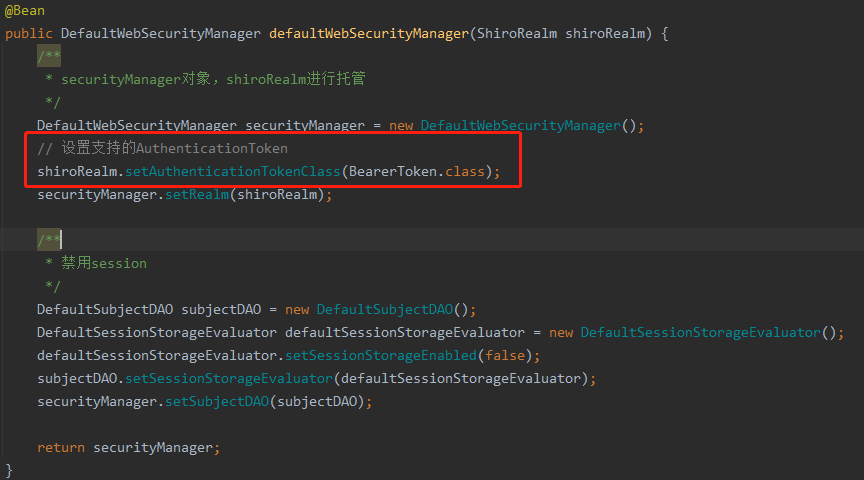
再次尝试,登陆成功,listUser接口也返回数据
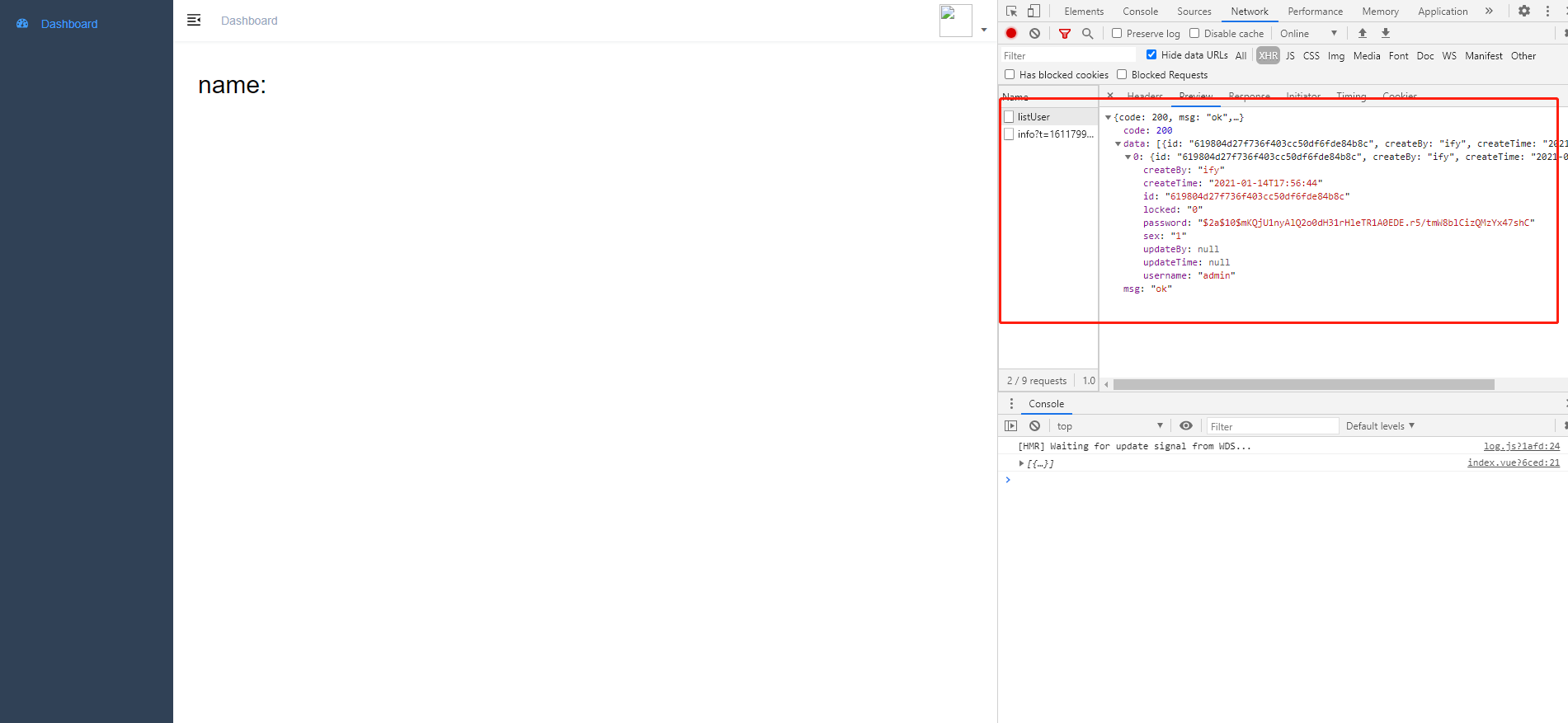
redis里token信息存储进去了。
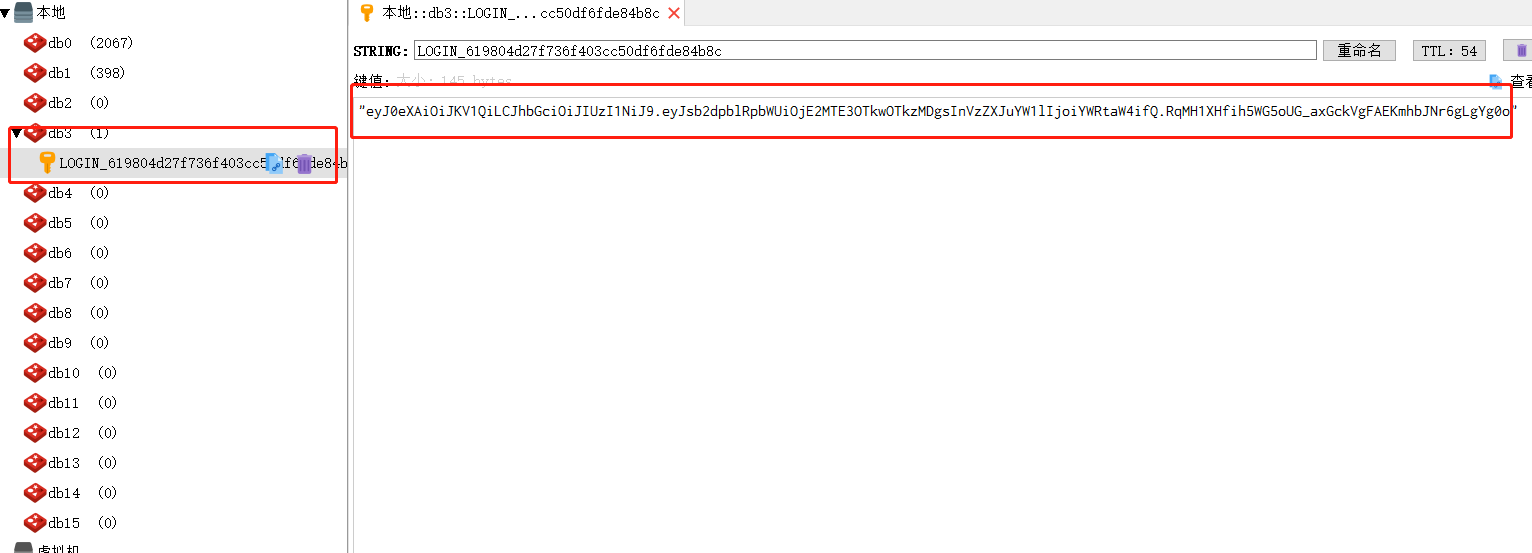
刷新页面
token过期,跳转登陆页,提示重新登陆
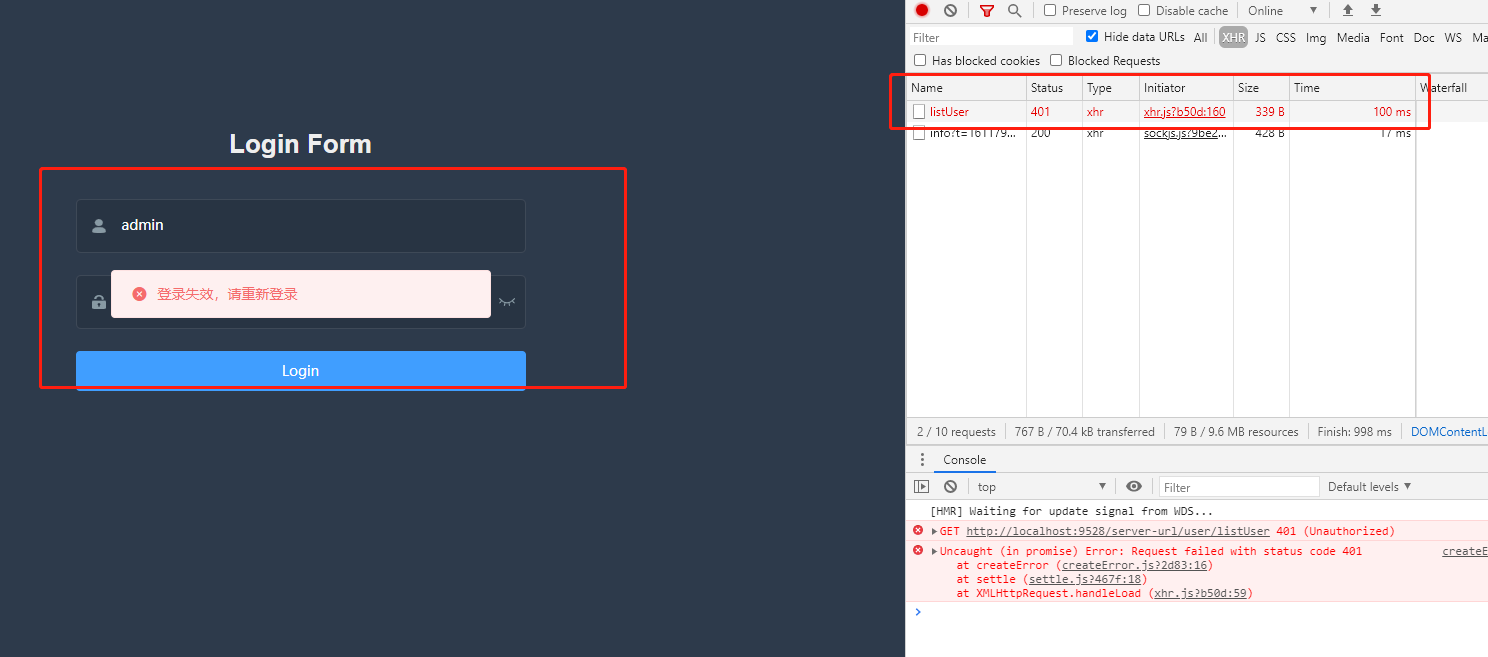
总结
这篇文章主要实现用结合shiro + jwt + redis来完善登陆和实现请求身份认证。本来以为会挺顺利的,没想到踩到了一些坑,哈哈哈。





 本文详细介绍了如何使用Shiro框架结合JWT和Redis实现登录认证流程。包括Shiro配置、自定义拦截器、登录逻辑、权限验证以及前端请求处理。流程涉及浏览器请求、身份认证、token生成和存储、过期处理等关键步骤,确保了用户身份的安全和有效。
本文详细介绍了如何使用Shiro框架结合JWT和Redis实现登录认证流程。包括Shiro配置、自定义拦截器、登录逻辑、权限验证以及前端请求处理。流程涉及浏览器请求、身份认证、token生成和存储、过期处理等关键步骤,确保了用户身份的安全和有效。
















 692
692

 被折叠的 条评论
为什么被折叠?
被折叠的 条评论
为什么被折叠?








